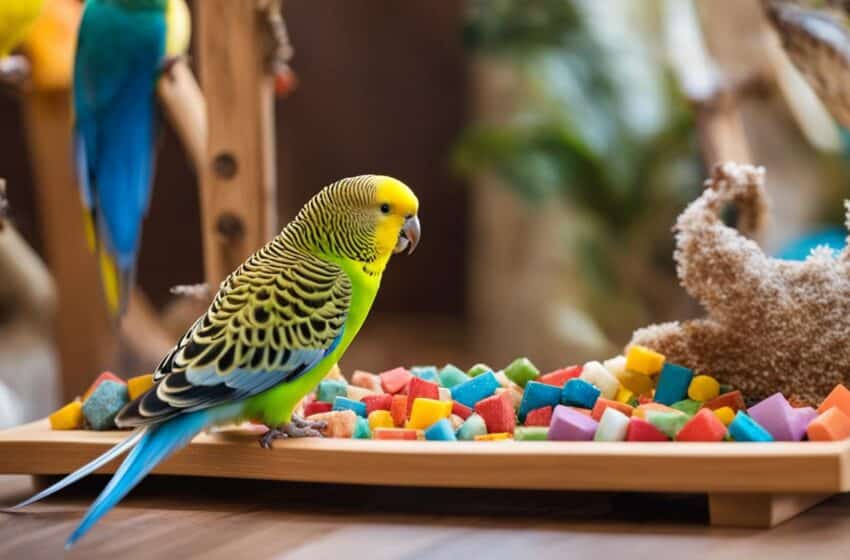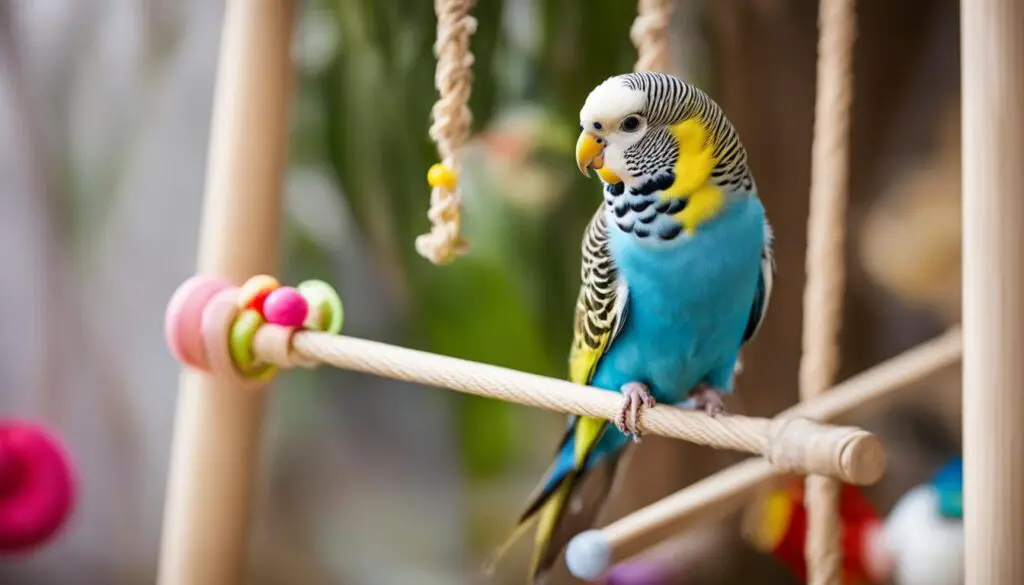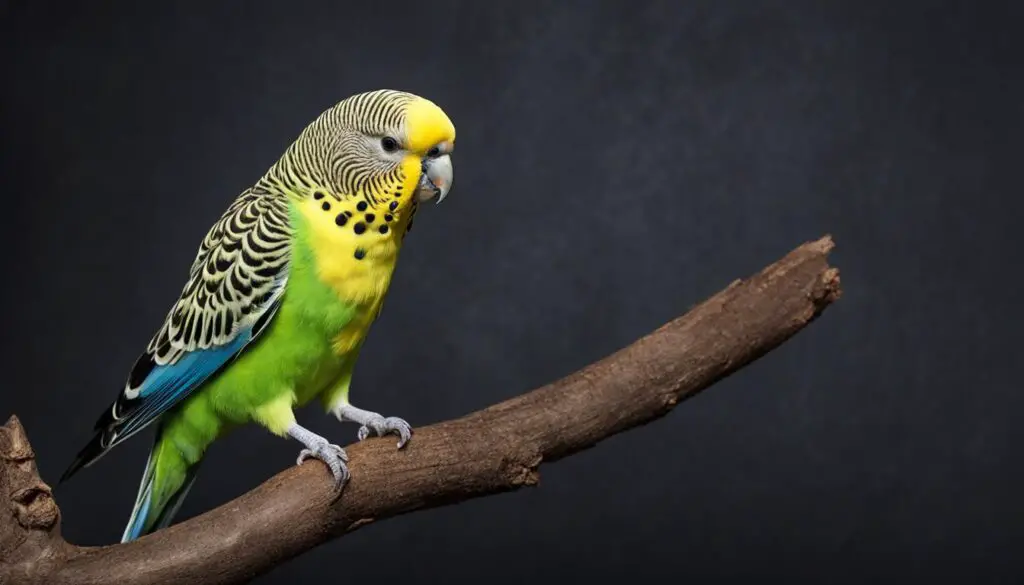The Art of Socializing Your Budgie Effectively

Budgies, also known as parakeets, are social and intelligent birds that can make wonderful companions. However, they require proper socialization to develop a strong bond with their owners and thrive in a human environment. In this article, I will share some effective budgie socialization tips to help you nurture a friendly and engaging relationship with your feathered friend.
Key Takeaways:
- Understand your budgie’s personality and needs to tailor your socialization approach.
- Gradually introduce your presence to build trust and create a positive association.
- Handle your budgie gently, using taming techniques and positive reinforcement.
- Provide supervised out-of-cage time for socialization and mental stimulation.
- Approach socialization with respect, kindness, and consistency to foster a strong bond.
Understand Your Budgie’s Personality and Needs
Before embarking on the socialization journey, it’s essential to understand your budgie’s personality and needs. Budgies exhibit unique behaviors and temperaments that can vary from bird to bird. Some budgies are naturally outgoing, adventurous, and quick to form connections, while others may be more reserved and cautious. Observing your budgie’s behavior and adapting your socialization approach accordingly is key to ensuring a positive and successful experience.
To truly understand your budgie’s personality, take note of their interactions with their environment and other budgies if you have a companion for them. Is your budgie playful and energetic, or does it prefer a quieter and calmer environment? Do they show curiosity towards new toys or become apprehensive? These observations will help you tailor the socialization process to meet their individual needs and preferences.
In addition to personality, providing a suitable environment is essential for your budgie’s well-being and social development. Consider the following aspects when creating a budgie-friendly space:
- Cage size: Ensure your budgie has enough room to move around, stretch its wings, and exercise. A spacious cage allows for natural perching and hopping, promoting physical health and mental stimulation.
- Toys and enrichment: Include a variety of toys and perches in the cage to keep your budgie entertained and engaged. Budgies enjoy exploring, climbing, and chewing on toys, so providing a diverse range will cater to their natural behaviors and prevent boredom.
- Balanced diet: Proper nutrition is crucial for your budgie’s overall health and well-being. Offer a varied diet that includes high-quality pellets, fresh fruits and vegetables, and occasional treats. Consult with an avian veterinarian to ensure you are meeting your budgie’s specific dietary needs.

Understanding your budgie’s personality and addressing its needs are essential foundations for successful socialization. By creating an environment that caters to their individuality and providing appropriate stimulation, you set the stage for a positive and fulfilling bonding experience. Remember, every budgie is unique, and patience, consistency, and love are key to building a strong and trusting relationship with your feathered friend.
Gradual Introduction to Human Presence
Building trust is the foundation of successful budgie socialization. Creating a positive and comfortable environment for your budgie to interact with you is essential for developing a strong bond. The gradual introduction of human presence is a crucial step in building trust with your feathered friend.
Sit near the cage:
Begin by spending time near the budgie’s cage. Position yourself in a way that allows the budgie to see and hear you clearly. This helps familiarize them with your presence and allows them to observe your behavior.
Talk softly:
Engage in gentle conversation with your budgie, using a soft and soothing tone of voice. This not only helps your budgie become accustomed to the sound of your voice but also establishes a positive association between your presence and calm, comforting noises.
Offer treats:
Use treats as positive reinforcement during your interactions with the budgie. By offering their favorite treats, you create a link in their mind between your presence and a rewarding experience. This encourages trust and positive associations.
As your budgie becomes more comfortable with your presence, you can gradually extend your interactions:
Place your hand near the cage:
Once your budgie is relaxed and shows signs of trust, try placing your hand near the cage. Keep your hand still and avoid sudden movements that may startle the budgie. Allow them to approach at their own comfort level.
Respect boundaries:
Pay attention to your budgie’s body language and vocal cues during these interactions. If they show signs of fear or discomfort, respect their boundaries and give them space. Building trust is a gradual process that requires patience and understanding.
Remember to always approach your budgie with patience and consistency. Each budgie is unique and may require different amounts of time to build trust. By gradually introducing your presence and creating positive associations, you can establish a strong bond and lay the groundwork for a trusting relationship.

Quote:
“Building trust with your budgie is like laying the building blocks for a lifelong friendship. Take it slow, be patient, and let trust grow naturally.”
Gentle Handling and Taming Techniques
Once your budgie is comfortable with your presence, it’s time to begin the process of gentle handling and taming. Building trust is key to establishing a strong bond with your budgie. Here are some techniques to help you with budgie taming, hand-taming budgie, budgie step-up training, and budgie trust-building exercises.
Step-Up Training
One of the first steps in taming your budgie is teaching them the “step-up” command. This command involves offering a perch or your finger for the budgie to step onto. Start by placing your finger or a perch near your budgie and use a gentle, upward motion to encourage them to step onto it. Make sure to reinforce this behavior with positive reinforcement such as treats and praises. With consistent training, your budgie will become more comfortable stepping up onto your hand.
Gradual Increase in Duration
Once your budgie is confident with stepping up, gradually increase the duration of time they spend perched on your hand. Start with short intervals and gradually extend the time. This helps them develop trust and familiarity with your presence. Remember to provide positive reinforcement during these interactions to encourage your budgie’s trust and cooperation.
Positive Reinforcement Techniques
Positive reinforcement is crucial in gentle handling and taming. Use treats, praises, and gentle strokes to reward your budgie for desirable behaviors. This will help them associate your presence and touch with positive experiences. Avoid using force or punishment, as this can create fear and hinder the trust-building process.
Respecting Boundaries
It’s important to respect your budgie’s boundaries during the taming process. Observe their body language and signs of fear or resistance. If your budgie appears uncomfortable or tries to escape, give them space and try again later. Pushing your budgie beyond their comfort zone can damage the trust you’ve built. Patience and understanding are key in developing a strong bond with your budgie.
| Benefits of Gentle Handling and Taming Techniques: |
|---|
| Builds trust between you and your budgie |
| Allows for easier handling and interaction |
| Enables bonding and a sense of companionship |
| Promotes positive behaviors and cooperation |
Remember, budgie taming and trust-building exercises require patience, consistency, and respect for your budgie’s individual needs. Each budgie is unique, so adjust your techniques to suit their personality and preferences. With time and effort, you will develop a strong, trusting relationship with your budgie.
Encouraging Socialization Outside the Cage
Allowing your budgie supervised out-of-cage time is essential for their socialization and mental stimulation. Creating a budgie-proofed area where your bird can safely explore and fly, if flighted, is key to promoting their well-being. Offer a variety of perches, toys, and interactive activities to keep them engaged during their out-of-cage time. This not only provides physical exercise but also encourages natural behaviors such as climbing, hopping, and flying.
To ensure their safety, closely supervise your budgie during these sessions to prevent accidents or escapes. Always be mindful of any potential hazards in the environment and remove them beforehand. A well-socialized budgie will gradually become more comfortable and confident outside the cage with regular out-of-cage time.
If you have other pets in the household, it’s important to introduce them to your budgie gradually and under controlled circumstances. Use positive reinforcement techniques and closely monitor their interactions. Ensure that the environment is calm and quiet, allowing your budgie to feel secure. Remember, each budgie and pet’s temperament is unique, so be patient and attentive to their reactions.
Providing opportunities for your budgie to explore outside the cage fosters their natural curiosity. It allows them to discover new environments, textures, and sounds, which can contribute to their mental stimulation. Out-of-cage time also strengthens the bond between you and your budgie, as they learn to trust and rely on you as their caregiver. The more comfortable they become with the outside world, the more confident and adaptable they will be in different situations.
Budgie out-of-cage time encourages socialization, mental stimulation, and the development of trust and communication between you and your budgie.
| Benefits of Budgie Out-of-Cage Time | How to Encourage Budgie Socialization Outside the Cage |
|---|---|
|
|
Conclusion
Socializing your budgie is a gradual process that requires time, patience, and a deep understanding of your budgie’s individual needs and preferences. By following these budgie socialization tips, you can nurture a friendly and engaging companion while fostering a strong bond between you and your budgie.
Remember to always approach socialization with respect, kindness, and consistency. By building trust through gradual introductions, gentle handling, and taming techniques, you can establish a solid foundation for successful budgie bonding.
Allowing your budgie supervised out-of-cage time not only provides them with mental stimulation but also encourages socialization and exploratory behavior. Create a safe environment and gradually introduce them to other pets if applicable, helping them build confidence and adaptability.
Enjoy the journey of building a lifelong relationship with your budgie. With time and dedication, you can create a strong budgie-human relationship filled with love, trust, and companionship.
FAQ
How long does it take to socialize a budgie?
The time it takes to socialize a budgie can vary depending on their individual personality and past experiences. It can take anywhere from a few weeks to several months for a budgie to become comfortable and bonded with their owner.
How often should I interact with my budgie?
Regular interaction is essential for building a strong bond with your budgie. Aim for at least 1-2 hours of daily socialization time, divided into shorter sessions to prevent boredom or stress.
Can I socialize my budgie if they are afraid of me?
Yes, you can still socialize your budgie even if they are initially afraid. Start by creating a positive association with your presence and gradually introduce gentle handling techniques to build trust over time.
How can I tell if my budgie is comfortable with me?
Some signs that your budgie is comfortable with you include relaxed body posture, vocalizations of contentment, stepping onto your finger or hand voluntarily, and preening in your presence.
Can I socialize my budgie with other pets in the household?
Yes, it’s possible to socialize your budgie with other pets, but it should be done under close supervision. Introduce them gradually, ensuring the safety and well-being of all animals involved.
What if my budgie refuses to step up on my finger?
If your budgie is refusing to step up, it may be a sign that they are not yet comfortable or trusting enough. Keep working on building trust and try using positive reinforcement techniques such as treats to encourage them.
Is it normal for my budgie to bite during socialization?
Budgies may nip or bite during socialization, especially if they feel threatened or stressed. It’s important to understand their body language and respect their boundaries. Gradually, as trust is built, biting behavior should decrease.
Can I train my budgie to do tricks during socialization?
Yes, budgies are intelligent and can be trained to do tricks through positive reinforcement. Keep training sessions short, fun, and rewarding to engage your budgie’s interest and cooperation.
How can I introduce my budgie to out-of-cage time?
Start by creating a safe and budgie-proofed area where your bird can explore. Gradually increase the duration of out-of-cage time, ensuring supervision and providing perches and toys to keep them entertained.
What if my budgie gets scared during out-of-cage time?
If your budgie gets scared during out-of-cage time, calmly and gently encourage them to return to their cage. It’s important to provide a secure and comforting environment for them to feel safe.



